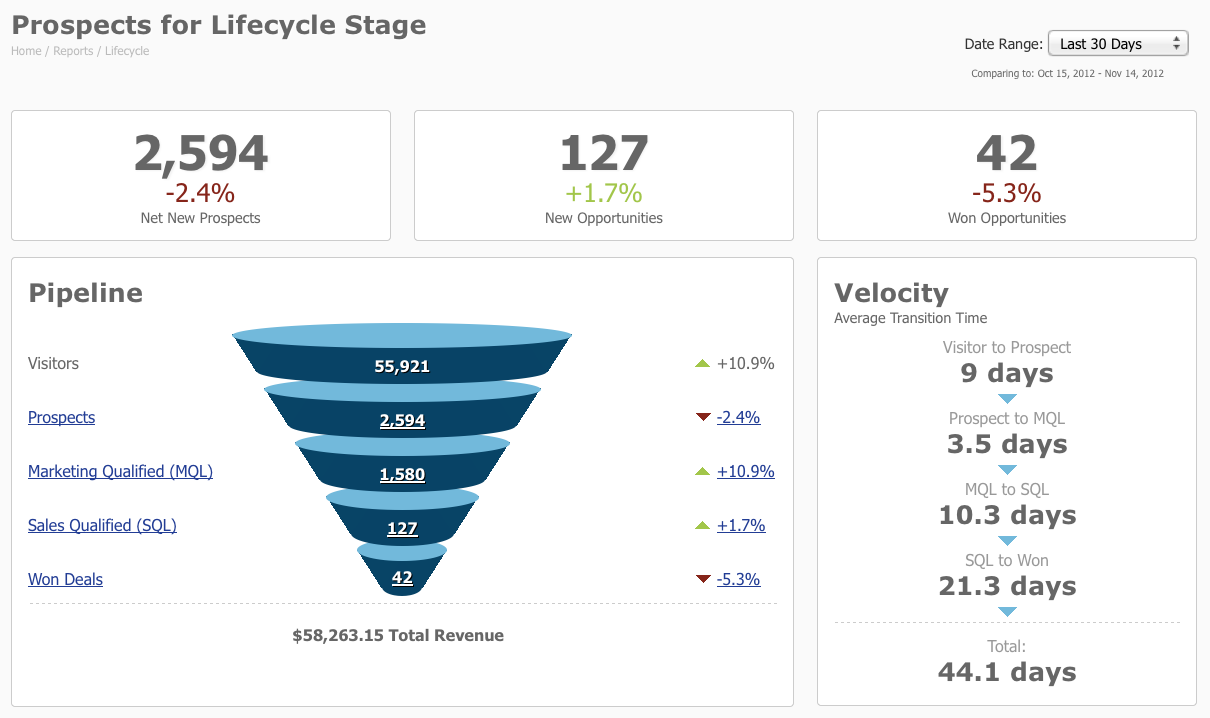Finding the right metrics using Pardot
We created a newsletter to help Pardot users expand their knowledge on (and love for) Pardot. Sign up for your dose of marketing automation goodness here.
When I was first hired to build a marketing department for Idealist Consulting, I measured what felt like hundreds of metrics: Facebook likes, Salesforce AppExchange rankings, most popular pages on our website, I could go on. And on. At the time, it felt like throwing spaghetti against the wall but I was so excited by all those NUMBERS - it made me feel like I was doing something critical. Lots of critical things. I certainly felt busy.
In retrospect, I think I had to start out this way. For one thing, I was still fairly new to marketing, so I was wrapping my head around that delicate balance between channels, audiences, and partnerships. But more importantly, I needed a baseline. I needed full immersion into everything on the ground level before I could step back and look at the full picture and figure out what mattered.
I started thinking about this recently at our local Pardot User Group when the topic of metrics came up. Everyone around the table wanted to better show their value as a marketer, and also prove the value of Pardot to their boss. But here’s the thing:
It takes discipline to pick the right marketing metrics
Yup, just like anything worth doing, it’s hard work. But not impossible, especially if you have marketing automation at your disposal.
In this blog post, I’ll show how you can use Pardot to measure your marketing team’s impact. You can take these steps as small or big as you want, and they will almost certainly help you have a year-end conversation with your boss about the value of marketing automation and what your team has done to influence revenue in 2017.
Step 1: identify your baseline
As my spaghetti-throwing story above shows, it pays to develop a broad understanding of your channels, but often the move to marketing automation will illuminate gaps that can be very helpful to show your baseline. Here are three examples:
Pre-Pardot baseline for ENGAGEMENT:
Google Analytics list of most popular blog posts.
At Idealist Consulting before using marketing automation, we knew what website pages were most popular (through Google Analytics), but could not tell you which were being read by clients or high-value leads.
Pre-Pardot baseline for LEAD QUALITY:
Salesforce dashboard on what sources convert to opportunities.
We had a vague sense that certain sources, such as our Engagement Party at Dreamforce, were as high-converting as our inbound marketing sources, such as prospects who had downloaded whitepapers. But before we started using Pardot we did not have any objective data. I tracked the quantity of inbound leads from whitepapers, webinars, etc. but not the quality.
Pre-Pardot baseline for MARKETING-SALES ALIGNMENT:
Salesforce dashboard on the number of leads converted to opportunities.
As a small company I have always had a good relationship with our sales team, but before Pardot our conversations were mainly focused on the quantity, not the quality of leads. We also had a lot of talk about blog posts that sales needed in order to have specific conversations but, before marketing automation, we didn’t have a way to organize those requests in a strategic way.
Step 2: show how you have moved the needle
Next, think about how Pardot has let you improve on these baseline points. Here’s how it’s looked for us:
Post-Pardot improvement for ENGAGEMENT:
Pardot segmented lists of high prospect scores.
Pardot scoring tracks everything from email opens and clicks to webinar attendance and website page views. The higher someone’s score gets, the more engaged they are. Now we still look at Google Analytics for general content trends that can inform future content choices, but we also look regularly at lists of high scores to see what type of content is most popular with what type of audience.
Post-Pardot improvement for LEAD QUALITY:
Pardot segmented lists of high prospect scores
Pardot grading gives a higher grade (A, B, C, etc.) to people who fit your ideal client profile. For us, this includes data points like industry and company size. We have built out segmented lists based on high scores and can take action like creating engagement programs for high-value leads who are also highly engaged. Starting in 2018, we will be tracking MQLs, marketing qualified leads, on a monthly basis so that we can show how many people fit our ideal profile. So instead of just saying “Marketing has produced X leads through whitepapers,” I can say “Marketing has produced X leads through whitepapers that fit our ideal client profile, and I’m confident they will convert to better opportunities if we nurture them.”
Post-Pardot baseline for MARKETING-SALES ALIGNMENT:
Marketing Qualified Leads (MQLs) and Sales Qualified Leads (SQLs)
Pardot has MQLs and SQLs built into their Lifecycle Report, but you can’t customize it based on your company’s definitions. However, you can build out your own MQL and SQL dashboards based on Salesforce data points, then consider how Pardot tools can help increase these numbers, which is what we have recently done at Idealist Consulting.
Looking ahead to 2018, I plan to have monthly chats with our sales director about our MQLs and SQLs based on Salesforce dashboards so we can talk in real-time about whether the current volume and quality is working, and course-correct sooner if we have a down month.
Step 3: show how this connects to larger company goals
As Susie Wittbrott from marketing firm Kinesis recently wrote, “marketing metrics are only valuable insofar as they move your business goals forward.” At the end of the day, Pardot will be most valuable if you can use it to connect your marketing activities to real company revenue. To do this you need to have several basic things in place:
- You must track Opportunities in Salesforce so that you can use this data in Pardot.
- You must track lead source on every new lead, such as whitepapers or events, so that Pardot can then help show you the ROI of your marketing team endeavors.
Here are a few tools in Pardot and Salesforce that may be helpful to you as you explore this:
The Lifecycle Report
This report is based on the traditional sales funnel concept, where you move from “top of the funnel” Visitors (everyone who visits your website) to Won Deals (everyone who has an Opportunity assigned to them). Typically, a marketing department works with prospects up to the Marketing Qualified Lead (MQL) stage, then Sales takes over at Sales Qualified Lead (SQL) stage.
As I mentioned above, this report comes with a big caveat which is that you can’t customize it based on your own company’s definition of MQL and SQL. For us at Idealist Consulting has meant that it is not a helpful report since we define MQL as people who meet our ideal client profile, not simply people who have been assigned to a Pardot user. However, this report has still been useful for us to internally start conversations with our Sales team about what MQL and SQL mean to us.

Your Salesforce Dashboards
While the Pardot Lifecycle funnel report is pretty, at Idealist Consulting we’ve had more success tracking our monthly metrics through Salesforce Dashboards. We can use filters to directly identify MQLs as people who fit certain criteria of company size and industry, then we can build reports showing conversion rates of certain lead sources over time. Looking ahead to 2018, we’re excited to dive deeper into campaign attribution as beta testers for the new Pardot Edge Pilot- stay tuned for future posts on our experience with that.
Don’t stop digging into your data
Once you have started a conversation around baseline, improvements, and larger strategic implications of your team’s work, it may be enticing to rest on your laurels. Please don’t! Using Pardot gives you constant access to data that will challenge your assumptions and suggest new ways of doing your work. Be disciplined and devote yourself to revisiting your metrics on a monthly or at least quarterly basis, and have conversations regularly between marketing and sales to see how your metrics are working for other people, too.
For us at Idealist Consulting, marketing automation has let us reduce the noise to our clients and we have developed an internal culture of focusing on educating our prospects rather than selling. This combined with the objective metrics of attribution and conversions makes Pardot and our marketing team integral to every aspect of business function.
Want to find the right metrics for you? Need a refresher on how to build a report? Check out our “How to build a report in Salesforce Lightning” tutorial where we walk you through report building, along with how to sort data and add bucket fields.
















